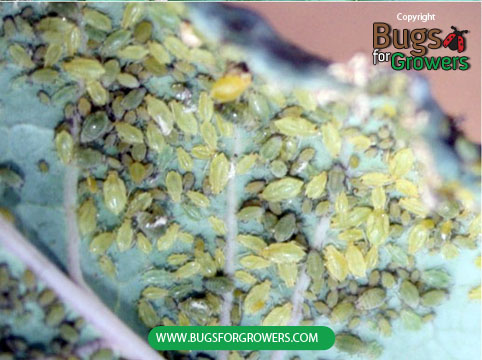Aphid killer wasp, Aphelinus abdominalis
1. Aphid killer wasps, Aphelinus abdominalis are commercially available.
- Aphid parasitic Aphelinus abdominalis wasps are excellent biological control agents that occur naturally in the gardens or fields but their numbers are not always enough to suppress the population of aphids at the considerable level and prevent the damage caused by aphids.
- Therefore, Aphelinus abdominalis wasps are now commercially produced on a large scale and sold to growers as adults or “aphid mummies (from which adult wasps emerge)” to supplement the low populations of naturally occurring wasps for the effective management of various species of aphids responsible for causing an economic damage to many economically important crops grown in the greenhouses, fields, organic vegetable gardens and orchards.
2. Aphid killer wasps, Aphelinus abdominalis have a wide host range.
Aphelinus abdominalis wasps feed on a wide range of host species of aphids that cause a serious damage to different crops.
Following are the few examples of aphid hosts of Aphelinus abdominalis wasps.
- Alfalfa aphid, Acyrthosiphon pisum
- Bird cherry-oat aphid, Rhopalosiphum padi
- California Laurel aphid, Euthoracaphis umbellulariae
- Cereal aphid, Sitobion avenae
- Cotton aphid, Aphis gossypii
- Green peach aphid, Myzus persicae
- Melon aphid, Aphis gossypii
- Potato aphid, Macrosiphum euphorbiae
3. Aphid killer wasps, Aphelinus abdominalis are easy to handle and release in aphid infested greenhouses or fields.
- Aphelinus abdominalis are shipped as mummies in small vials. Mummies are parasitized dead aphids that are filled with wasp pupae. Adults of parasitic wasp generally emerge from these pupae inside the mummies and then they emerge from mummies by cutting an exit hole.
- Upon arrival, the packages of wasps can be stored in a dark and cool place until you are ready to release wasps in the garden, field or greenhouse.
- Wasps should be released in the garden, field or greenhouse within 15-20 hours of their arrival.
- Avoid direct exposure of mummies to sunlight that can kill them.
- If ants are present on aphid-infested plants, control them first before releasing Aphelinus abdominalis wasps, as ants will defend aphids from these parasites to protect their honeydew food. If ants are not controlled, effectiveness of wasps as a parasite will be reduced.
- As a preventive measure, release 4-5 adult wasps per 100 square ft. weekly by opening vials and walking slowly in the garden or greenhouse. Adult wasps should escape themselves from the vials. Then randomly place the un-hatched mammies in shaded areas in the garden, field or greenhouse so that adult wasps will emerge in the as soon as they mature.
- As a curative measure, release 25 -30 mummies or hatched wasp adults per 100 square ft. weekly in the colonies of aphids or in the heavily aphid infested areas in the vegetable gardens, greenhouses or fields.
4. Aphid killer wasps (Aphelinus abdominalis) are quick to find aphid colonies.
- Adults of Aphelinus abdominalis generally use alarm signals produced by aphid infested plants and smell of honeydews secreted by aphids on the infested plants to find aphid colonies (Photo 1).
- Once in the aphid colony, they also use their antennae to select a suitable size aphid for laying eggs in aphid body.
- Aphelinus abdominalis wasps perform better against aphids when temperatures are between70 and 77°F and relative humidity between 60 and 80%.

5. Aphid killer wasps, Aphelinus abdominalis have an ability to recycle.
- When adults of Aphelinus abdominalis are released in the aphid infested areas, they will follow alarm signals produced by aphid infested plants and smell of honeydews secreted by aphids on the infested plants to find aphid colonies.
- Once in the aphid colony, females of Aphelinus abdominalis will use their antennae to select a right size aphid for laying eggs. Females will insert tip of their ovipositor into the ventral side of aphid abdomen and lay eggs in the body of aphids.
- Within the aphid body wasp eggs will hatch into young larvae that feed on the body content of aphid and complete their development within the aphid body.
- While wasp larvae are feeding on the body content, parasitized aphids will be still alive, reproduce and feed on plant tissue for a while but they will die as soon as the larvae of Aphelinus abdominalis wasp become mature and pupate.
- These dead aphids will then turn into “mummies” (which are commercially sold to use as biological control of aphids).
- After 14- 15 days, adult wasps will start emerging from mummies again and life cycle continues.
6. Aphid killer wasps, Aphelinus abdominalis are not harmful.
- Aphelinus wasps are safe to animals, humans and the environment.
- They do not cause damage to plants.
- They are not harmful to the personnel involved in their production and application.
- Wasp treated food products are safe to handle and eat.
